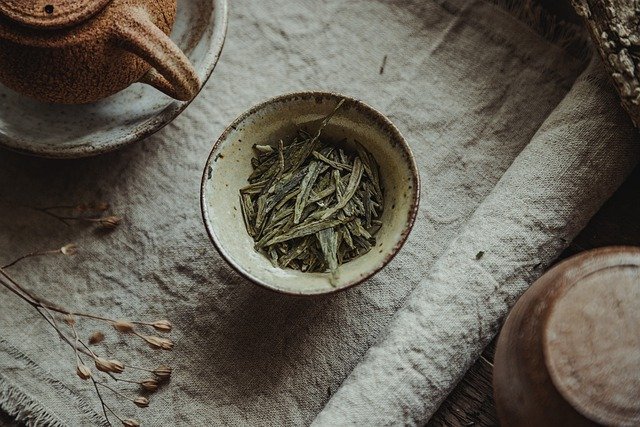
It is one of the 10 best green teas in the world. It is the tea of the 4 perfects : leaf, color, aroma and flavor.
It is not strange that (as always) it was intended for the emperors (always all the good teas were for the emperors) Today we are all a bit like emperors since you can enjoy it like them, like the emperor you are (yes, only your house).
Today, and thank God, many types of green teas are known. Within the pure green teas the best known are usually:
- Sencha
- Bancha
- Gyokuro
- Kukicha
However, the origin of the tea is from China and they have some sensational pure green teas such as Lung Chin or Dragon well green tea or Lonjing tea.
As usual, the names of Chinese teas are usually referred to by different names, this is due to the translations that are made from Chinese (Lung Chin means Dragon well in English)
But what is Lung Ching green tea? What makes it so different? Why is it so appreciated?
Let’s go to the mess!
What is Lung Ching tea or Dragon Well tea?
Lung Ching tea or Dragon Well tea is a type of green tea originating from the Lonjing (Good Dragon) region located northwest of the city of Hangzhou. It is characterized by being made in a traditional Chinese way with the first annual harvest of the tea tree or Camelia Sinensis, obtaining a tea with a flat appearance and a soft, greenish-yellow broth with an herbal flavor, a toasted point with a light almond aftertaste.
Let’s analyze this definition and you will see why it is one of the best 10 green teas in the world :
1.Green tea
It is one of the 5 types of tea that exist: green, black, white, red and Oolong tea.
Green tea is characterized by being a tea without oxidation or fermentation, that is, it is basically just leaves of the tea tree (Camelia Sinensis) collected and dehydrated.
100% natural tea!
2. Originally from the Lonjing region
It is a small area of China where fabulous teas are made due to its weather conditions and the industriousness of its farmers.
This green tea is harvested at an altitude of about 1,000 meters, so it maintains a fine and elegant bouquet.
But this type of tea is also made in other areas.
3.It is made in a traditional Chinese way
We have found the first great characteristic of this tea.
In an artisanal way, that is, it is harvested by hand leaf by leaf when it is at the optimum moment.
The harvest time is about 6 weeks, the first two being the highest quality.
It is made in a traditional Chinese way, that is to say that the leaves are roasted by hand on the same day in a frying pan (a big difference with Japanese teas).
4.With the first harvest
Here is the second big important feature!
Tea is normally harvested two to three times a year between April and October (mid-spring and autumn harvest).
Only the shoot and the first two leaves are harvested.
From the spring harvest, the shoots and leaves are obtained that are more tender than the other two harvests, since they are less lignified (they have less cellulose) and their content of other substances such as catechins and flavonoids is higher.
5.Flat appearance
To make a good Lung Ching, the shoots and first leaves of the plant are used, which are flattened by hand in woks by experts. This gives them their characteristic flattened shape and green/gold color.
This tea is reminiscent of Bancha green tea due to its shape, because the leaves are flat, as if they were crushed, but they are shorter than those of Bancha (remember that only the leaves of the spring shoots are used, which are shorter) and the color is more intense.
6.Greenish yellow broth
Not deep green like Gyokuro, not pale yellow but like a soft golden green
7.Mature and soft flavor
All the selection of leaves and the production process based on not oxidizing through perfect roasting in a pan make it have a delicious mild flavor that is not at all astringent.
Herbal, toasted point with a slight almond touch
Types of Lung Ching
I have told you before that there can be around 100 different types of lung ching. But how is it possible that there are so many varieties?
Basically because today we can consider that the Lung Ching is a subclass of green tea that has the following characteristics:
- Made with the leaves of the Spring harvest
- handcrafted
- The leaves are roasted in a pan.
- Its form of presentation is in flat sheets.
- But before it wasn’t like that and it shouldn’t be like that.
- The authentic Lung Ching must at least be from the Chinese province of Zhejiang
With which we already have a first classification by origin:
- Zhejiang
- Yunnan
- Guizhou
- Sichuan
- Guangdong
Within Zheijang province, they are produced in different villages, but the most authentic are the teas that come from the Xihu district. But the most famous are those of the West Lake plantations in Hangzhou.
In addition to the classification by geographical area, Lung Ching or Longjing teas are divided into 7 grades: the superior (qiqiang) and the special (queshe) after 1 to 5.
As if that were not enough, they are also classified by the time of collection. This tea is harvested for 6 weeks, considering the leaves of the first two weeks as the best (Pre-Quinming Longjing), those that come after the rains and when the temperature rises in the fields, making the plant grow faster. This is how they are classified into:
- Pre-Quinming(end of March to April 5),
- Pre-Guyu (April 6-20)
- Post-Guyu (from 21 onwards)
Now you understand why there are so many kinds of Lung Ching tea (geographical area, leaf grades and time of harvest), but all of them, with their nuances, are harvested and cooked by hand.
Lung Ching or Dragon Well Tea Mythology
The Chinese believed that the natural home of dragons was water. Thus the five main rivers of China were initially the homes of the five dragons: Yellow, Red, Blue, White and Great.
The way to write rain in Chinese consists of the characters ‘dragon’ and ‘cloud’, therefore rain is: ‘dragon in a cloud’.
Legend has it that around the year 250 BC, there was a terrible drought in China, which lasted for many years, with the crops failing.
As always, in all Chinese legends there appeared a Buddhist monk who was praying for many days and nights kneeling on a rock to the Dragon, and one day, water flowed from the rock on which he was praying.
The monk and the rest of the village were so relieved and grateful that the monk promised to name this place ‘The Well of the Dragon’. Eventually all the tea plantations in that area took on the same name, and since most teas in China are named after the place where they are grown, the teas picked there became Lung Ching tea.
Preparation of the Lung Ching.
This tea is very easy to prepare, like almost all green teas. You just need to introduce 2.5 grams (a tablespoon of tea) per cup in water heated to about 70-80ºC for two minutes.
This tea admits a second infusion, that is, make another tea with the used leaves.
Conclusions about Lung Ching tea

The unknown green tea Lung Ching or Dragon Well is considered among the 10 best green teas in the world.
Lung Ching tea or Dragon Well tea is a type of green tea that originates from the Lonjing (good dragon) region located northwest of the city of Hangzhou. It is characterized by being made in a traditional Chinese way with the first annual harvest of the tea tree or Camelia Sinensis, obtaining a tea with a flat appearance and a soft, greenish-yellow broth with an herbal flavor, a toasted point with a light almond aftertaste .
There are about 100 different types depending on their origin, grade, harvest time and purity.
Its mythological origin is related to Buddhist monks and dragons.
Its preparation is very simple, like almost all green teas: introduce 2.5 grams (one tablespoon of tea) per cup in water heated to about 70-80ºC for two minutes. And supports a second infusion.
